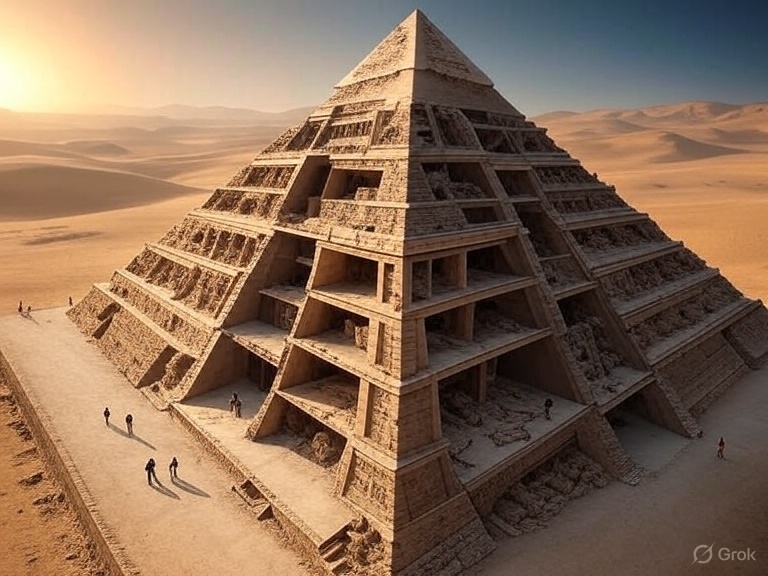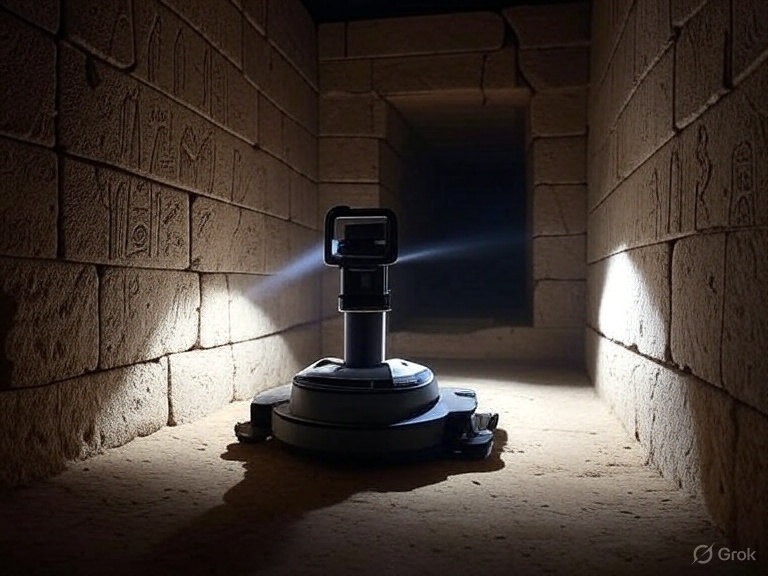The Great Pyramids of Giza have long fascinated historians, archaeologists, and engineers alike. Built over 4,500 years ago, these colossal structures remain among humanity’s most remarkable achievements. While much is known about their construction, recent discoveries of hidden chambers inside the pyramids have reignited debates: were these structures purely a product of human ingenuity, or do they hint at lost technology far beyond what we currently understand?
Discovering the Hidden Chambers
In 2017, researchers using muon tomography, a technique similar to X-ray imaging but using cosmic rays, detected a large void inside the Great Pyramid of Khufu.
- This chamber, roughly 30 meters long, remains unexplored due to safety concerns.
- Scientists speculate it could have served a structural purpose, acted as a storage chamber, or even been a symbolic corridor for pharaohs’ afterlife.
- Earlier studies had hinted at smaller hidden shafts and rooms, but the scale of this new discovery stunned the world.
These hidden chambers raise intriguing questions: how did ancient Egyptians achieve such precision, and could their techniques involve knowledge we have yet to rediscover?
The Engineering Genius of the Egyptians
Archaeologists emphasize that the pyramids are a triumph of human skill and planning:
- Mathematical Precision – The Great Pyramid’s base is aligned almost perfectly to the cardinal points, with less than 0.05-degree error.
- Massive Stone Transportation – Over 2 million limestone and granite blocks, some weighing 50 tons, were quarried, transported, and assembled with remarkable accuracy.
- Labor Organization – Contrary to earlier myths of slave labor, evidence suggests skilled workers and architects carefully coordinated the project.
Modern engineering studies reveal that ancient Egyptians understood principles of load distribution and structural stability, ensuring the pyramids have endured millennia.

Theories About Lost Technology
Some researchers argue that while the pyramids could be human-made, certain aspects defy conventional explanation:
- Precision Cutting – Some granite blocks were cut with tolerances finer than modern machinery can easily achieve.
- Unknown Lifting Methods – How workers lifted 50-ton blocks remains debated, leading to theories about advanced levers, ramps, or even lost mechanical devices.
- Symbolic Alignment – The pyramids’ alignment with stars, like Sirius and Orion’s Belt, suggests not just engineering but advanced astronomical knowledge.
Proponents of lost technology suggest that the Egyptians might have inherited techniques from an older civilization, or possessed knowledge that was later lost to history.
Hidden Chambers and Their Possible Functions
Archaeologists propose several possibilities for the purpose of these hidden chambers:
- Structural Stability – Some voids may act as pressure-relief zones, preventing collapse of upper chambers.
- Ceremonial Significance – Certain chambers may have housed sacred objects or symbols associated with afterlife beliefs.
- Storage or Tombs – Others may simply contain burial artifacts, yet to be discovered.
- Astronomical Alignment – Shafts and hidden passages may have been designed to align with specific celestial events, like solstices or star positions.
While the purpose is not yet fully understood, the mere presence of large hidden spaces highlights the sophistication of Egyptian design.
Modern Technology Revealing Ancient Secrets
Techniques like muon radiography, ground-penetrating radar, and 3D scanning are revolutionizing pyramid exploration.
- Muon tomography has allowed scientists to detect cavities without invasive drilling.
- 3D laser scanning maps every block in high detail, showing micro-cracks and movement over millennia.
- Robotic probes are being developed to navigate narrow shafts and explore previously unreachable chambers.
These technologies not only reveal hidden structures but also deepen our understanding of ancient engineering techniques.

Lost Knowledge or Human Ingenuity?
While some claim the pyramids’ hidden chambers hint at lost ancient technology, mainstream archaeology maintains that the Egyptians accomplished these feats with brilliant planning, teamwork, and simple tools.
- The “lost technology” argument often points to precision and lifting techniques beyond our modern expectations.
- Yet, historical evidence shows ancient civilizations were capable of incredible ingenuity, using trial-and-error, clever levers, ramps, and manpower.
- In fact, modern engineers often replicate pyramid construction using methods feasible with ancient tools, suggesting human innovation alone is plausible.
Cultural and Historical Significance
Beyond engineering, the hidden chambers carry immense cultural and symbolic importance:
- The pyramids reflect religious beliefs, particularly the pharaohs’ journey to the afterlife.
- Hidden chambers may have been ritualistic spaces, aligned with spiritual or cosmic symbolism.
- These discoveries remind us that the pyramids were more than tombs; they were sophisticated expressions of culture, religion, and science.
Conclusion: Marvels of Human Civilization
The discovery of hidden chambers in the pyramids sparks wonder and curiosity. While some speculate about lost technology or alien assistance, evidence points to human ingenuity, advanced planning, and extraordinary skill.
Modern technology continues to peel back the layers of these ancient monuments, revealing the genius of a civilization that thrived thousands of years ago. Whether you see them as proof of lost techniques or a testament to human capability, the Great Pyramids remain one of history’s most enduring mysteries.
As we explore further, each hidden chamber offers new insights, reminding us that the past holds secrets waiting for modern science to uncover.

